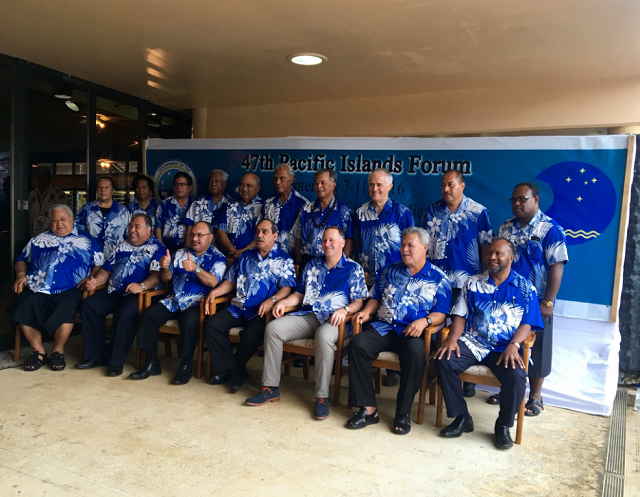
The absence of Fiji’s Prime Minister Frank Bainimarama from the recent Pacific Islands Forum’s Leaders’ Meeting in Pohnpei wasn’t a surprise: he hasn’t attended a Forum Leaders’ Meeting since 2007. But taking away the commission of his stand-in, Foreign Minister Ratu Inoke Kubuabola, while he was sitting in the absent PM’s chair at the Leaders’ Meeting was a surprise. So too was Fiji’s almost simultaneous announcement to withdraw support of the agreed legal text of the economic integration treaty PACER Plus sponsored by the Forum.
While each might have been an isolated event, these developments are consistent with a malaise eating away at the unity of the Forum as an effective regional body. After 45 years, the PIF is showing signs of a deepening confusion regarding its regional purpose. From its creation in 1971, the Forum’s struggled with whether it should be a political club of leaders setting the regional agenda or an aid implementing agency.
The 1972 Forum leaders had a bet each way: they decided to retain a club-like institutional informality, with annual meetings for themselves, while establishing a treaty-based organisation headquartered in Suva to administer aid projects. This inherent conflict of interest was largely glossed over for several decades: Australia and New Zealand sat in the Forum Leaders’ Meeting setting regional priorities, while their officials oversighted the implementation of aid projects through the organisation’s arm, where they were the principal donors.
Australia took an activist approach: it used the Forum to address perceived regional state incapacity to deal with terrorism and the misuse of sovereignty by some member states. The most notable intervention was the RAMSI mission in the Solomon Islands in 2003.
An ambitious long-term strategy for regional integration under the Forum was formulated in 2005. The ‘Pacific Plan’ was expected develop regional approaches that would be implemented by the Forum’s member states or regional agencies.
The 2005 Forum Leaders’ Meeting opened a treaty for signature to make the Forum an inter-governmental organisation, with the Leaders’ Meeting its decision-making arm. All eligible states signed the PIF Treaty almost immediately. But it’s still not in force more than a decade later. Dissatisfaction with the outcomes of the Pacific Plan resulted in the less ambitious ‘Framework for Pacific Regionalism‘ in 2014.
Last year the Forum’s unresolved duality became critical when the Third Pacific Islands Development Forum Summit of Leaders threw down the gauntlet regarding Australia’s and New Zealand’s role in the Forum, through its Suva Declaration on Climate Change. The following week, Forum Leaders endorsed the Suva Declaration, but with qualifications that worried island leaders; Australia and New Zealand didn’t feel obligated to follow this agreement in the Paris climate change summit. That stance cost Australia and New Zealand support within the Forum, as well European allies: they’d appreciated the Suva Declaration’s assistance for their strong climate change position at Paris.
This year political salt was rubbed into this regional wound when the 4th PIDF Summit endorsed the idea of a regional climate change treaty, with a provision aimed at Australia: it’d ban new or expanded coalmines. The gesture was symbolic: Australia wouldn’t be bound by it, not being a member of the PIDF and unlikely to join the treaty.
Overtly there’s no rivalry between the Forum and PIDF. But the raison d’être for the PIDF stems from Prime Minister Bainimarama’s determination to reduce or eliminate Australia and New Zealand’s decision-making role in the Forum. Institutionally there’s no contest between the bodies financially or politically. The Forum’s budget is in the tens of millions of dollars. The PIDF’s budget, relying on voluntary contributions, is said to be well under a million dollars.
Heads of Government absences from the Forum Leaders’ Meeting are generally very few. But the PIDF Summit this year only drew three heads of government. Some of the success the PIDF has claimed in giving a regional platform to business and civil society increasingly appears to be covered by the Forum. This shadowing of the PIDF by the Forum was also evident in Pohnpei when French Polynesia and New Caledonia were accorded full membership in the Forum Leaders’ Meeting.
Where the Forum goes after Pohnpei will partly depend on how Prime Minster Bainimarama chooses to shape relations between Fiji and its traditional friends and their role in the Forum. The PIDF still hasn’t been brought into the Council of Regional Organisations in the Pacific, the principal inter-agency mechanism for cooperation.
As the Prime Minister is now Foreign Minister, the means by which Fiji had re-established its participation with the Forum seems to be more vulnerable. Last week Prime Minister Bainimarama told the UN General Assembly that Fiji was ‘in the process of re-evaluating’ its relationships with the rest of the world and that in assuming the position of Foreign Minister he ‘intended to steadily reform this Ministry and refine certain aspects of our foreign policy. To give it a new direction and a renewed sense of purpose.’
If Bainimarama continues his personal boycott and another minister takes the Leader’s chair for Fiji at future Forum meetings, there’ll be a loss of corporate memory and perhaps less political support back in Suva. But not everything depends on Fiji or its view of what a healthy Forum might look like. Much will hang on the attitudes and views of the other members of the Forum, including Australia and how seriously they see the need for serious reform of the Forum, particularly its incompatible dual purposes. It’ll be fascinating to see how this plays out before Samoa hosts the Forum next year.